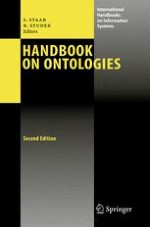2009 | OriginalPaper | Chapter
Description Logics
Authors : Franz Baader, Ian Horrocks, Ulrike Sattler
Published in: Handbook on Ontologies
Publisher: Springer Berlin Heidelberg
Activate our intelligent search to find suitable subject content or patents.
Select sections of text to find matching patents with Artificial Intelligence. powered by
Select sections of text to find additional relevant content using AI-assisted search. powered by
